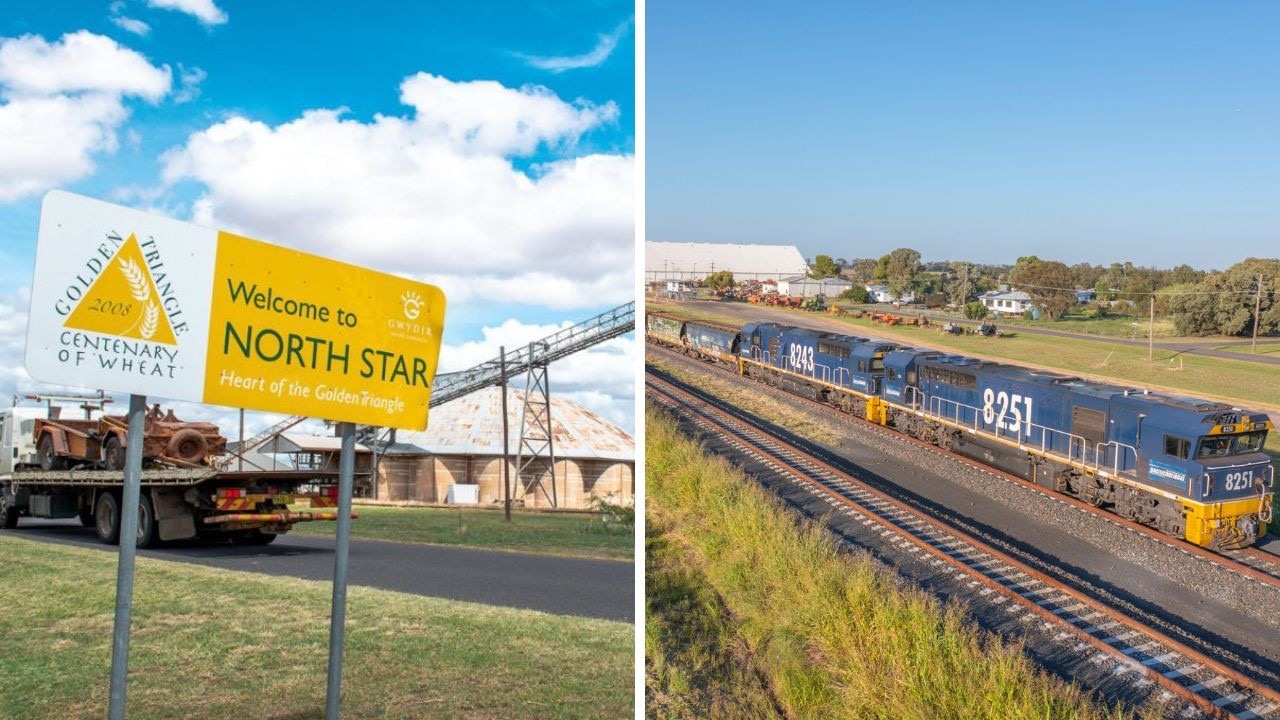If sleepy North Star is the end of the line for Australia’s $31.4bn Inland Rail project, it is also the end of the dream to revolutionise freight transport off the eastern seaboard.
The hamlet of 216, a dot in the tawny expanse of NSW’s northwest plains, could be as far as the planned rail corridor goes, burying a decades-long ambition to link Melbourne and Brisbane on a new cost-effective terrestrial trade route.
North Star boasts a golf course, one pub and an enrolment of 32 at the local school; should the Inland Rail terminate there, it would become a distribution hub for the bounty of some of Australia’s richest farmlands.
But those who stand to benefit most – the town’s residents and primary producers in Victoria, NSW and southern Queensland – agree this would defeat the purpose of a nation-defining project that has already had billions sunk into it.
Millions of tonnes of produce and goods would be transferred at North Star to or from twin-decked trains to complete the journey to port or domestic markets.
“If it stops at North Star you might as well pull it up and go and recycle the steel because you won’t get the return on capital,” said former deputy prime minister Barnaby Joyce, the veteran Nationals MP who represents the nearby federal seat of New England.

“You would have to build new highways in from Brisbane so the trucks could go to North Star.”
John Vermie, who owns the only cafe in North Star, said he couldn’t envisage how the village about 30km south of the Queensland border could be transformed into the terminus of Inland Rail.
“There’s nothing here, you’ve got a small cafe that struggles and a post office close by … there’s no accommodation … I don’t see why they get out and spend any money when there’s nowhere to go. I could see the cafe doing a little bit more in number, but that’s only because they have nowhere to go,” he said.
“I see how it could benefit some people … but it’s not a constant thing, there’s not 100 people coming through the town or 1000 people going through today.”
Nationals MP Mark Coulton, whose sprawling electorate of Parkes takes in the Inland Rail section from the Queensland border south to Dubbo, said it would be a “terrible waste” if it were to end at North Star.
“I think the white elephant tag would fit pretty squarely at this stage,” he said.
“There would need to be more investment in grain handling. I think, in North Star, that what is there now is quite dated.
When construction on Inland Rail started in 2018, the 1700km freight line was meant to run from Melbourne to Brisbane, but after a decade of political bickering and mammoth cost blowouts, there is growing doubt the project will ever make it north of the NSW border.
That puts North Star in the frame to be the end of the line.
The southern Queensland leg has been deeply controversial, with environmental approvals still “years away”, farmers concerned about impact on prime agricultural land, and engineering difficulties in navigating the topographically challenging Toowoomba range.
An Inland Rail representative said the organisation was still working with the state government to gain approvals for the Queensland leg of the track, but could not provide a start or completion date for construction.
“The Australian government will take decisions on future funding and construction of Inland Rail once it has been given greater certainty over cost and schedule of the project north of Narromine by Inland Rail’s securing all regulatory approvals and land acquisitions,” the representative said.
“Inland Rail has already received state and federal planning approvals for the Narromine to Narrabri and North Star to the Border sections, and the approvals process is ongoing in Queensland.”
If the line fails to make it past North Star, huge investment would be required to manage the thousands of trucks arriving from farms in southern Queensland that want to take advantage of faster speeds and double-stacked trains the Inland Rail route offers.
Industry sources have also blasted any suggestion of the line ending at North Star, warning it would not be commercially viable.
Work has already finished upgrading a 176km section of track from North Star down to Narrabri – a major cotton and wheat growing region – with trains now able to carry more freight, faster, to ports in Sydney and Newcastle.

Despite this, Inland Rail upgrades through NSW have already been a “game-changer” for producers, with trains last month restarting from the small town of Croppa Creek, 30km south of North Star. Trains can move canola from Croppa Creek to the Port of Newcastle four hours faster than before Inland Rail track upgrades and with 62 times more produce on board.
GrainCorp supply chain chief Josh Connell said Inland Rail had been a “massive advantage” and allowed the company to move more product to port to satisfy Europe’s growing appetite for Australian canola.
The section of track from North Star to Narrabri remains disconnected from the rest of the upgraded line further south that runs to Melbourne and another 300km of new track is needed to link the two. But if North Star were to become the end of the line, Mr Connell said, Queensland growers would have to pay more to truck grain and other produce to northern NSW.
“On a 40-wagon train running out of North Star, Croppa Creek going to Newcastle you will probably get a thousand tonnes more on it than what you will on a 40-wagon train running from Goondiwindi into Brisbane,” he said.
Federal Infrastructure and Transport Minister Catherine King has said the commonwealth was working with the Queensland government to “confirm the approach and time frames” to complete a business case.
“We are doing the work so we can make informed decisions to ensure that the project will meet our future freight needs,” she said.



